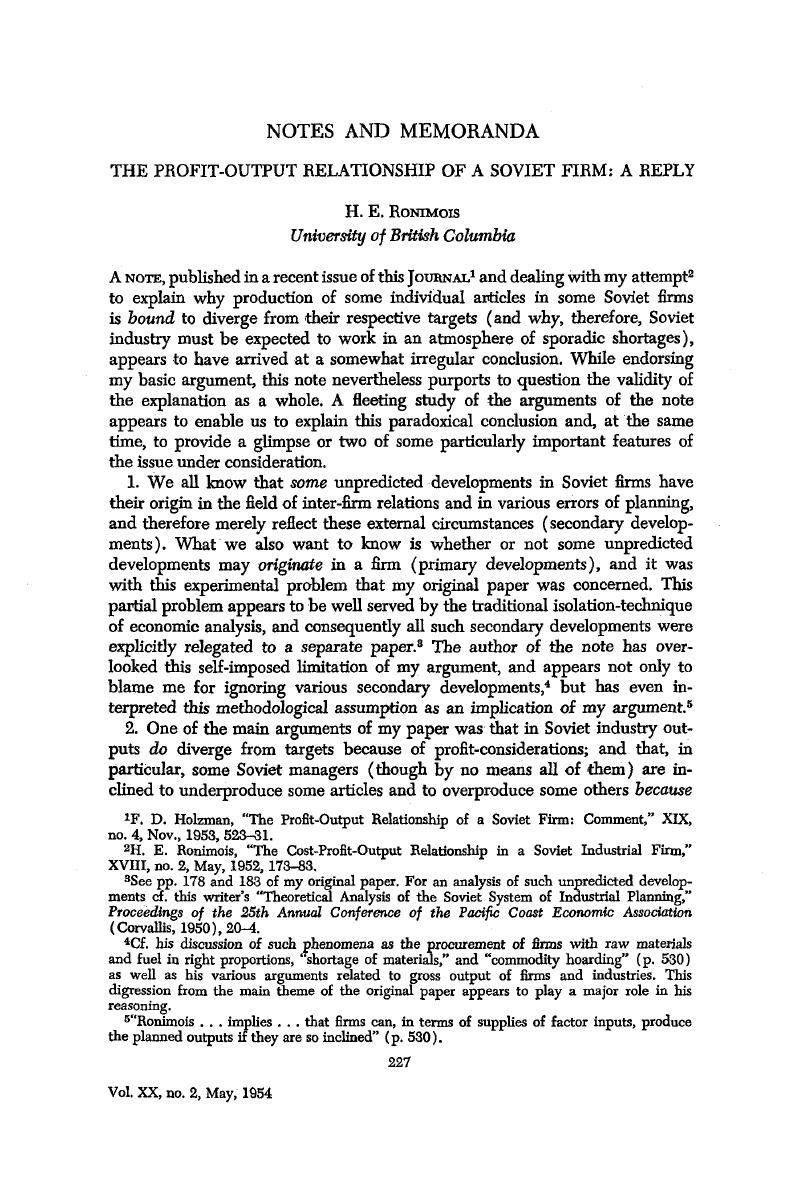No CrossRef data available.
Article contents
The Profit-Output Relationship of a Soviet Firm: A Reply
Published online by Cambridge University Press: 07 November 2014
Abstract

- Type
- Notes and Memoranda
- Information
- Canadian Journal of Economics and Political Science/Revue canadienne de economiques et science politique , Volume 20 , Issue 2 , May 1954 , pp. 227 - 232
- Copyright
- Copyright © Canadian Political Science Association 1954
References
1 Holzman, F. D., “The Profit-Output Relationship of a Soviet Firm: Comment,” XIX, no. 4, 11, 1953, 523–31.Google Scholar
2 Ronimois, H. E., “The Cost-Profit-Output Relationship in a Soviet Industrial Firm,” XVIII, no. 2, 05, 1952, 173–83.Google Scholar
3 See pp. 178 and 183 of my original paper. For an analysis of such unpredicted developments cf. this writer's “Theoretical Analysis of the Soviet System of Industrial Planning,” Proceedings of the 25th Annual Conference of the Pacific Coast Economic Association (Corvallis, 1950), 20–4.Google Scholar
4 Cf. his discussion of such phenomena as the procurement of firms with raw materials and fuel in right proportions, “shortage of materials,” and “commodity hoarding” (p. 530) as well as his various arguments related to gross output of firms and industries. This digression from the main theme of the original paper appears to play a major role in his reasoning.
5 “Ronimois … implies … that firms can, in terms of supplies of factor inputs, produce the planned outputs if they are so inclined” (p. 530).
6 ”Articles with ‘high’ prices are likely to be ‘over-produced’ and those with ‘low’ prices ‘under-produced’ ” (p. 180), “primarily on profit considerations” (p. 180), by managers who “have yielded to [the] temptation … to turn the Khozmchet into a semblance of the traditional two-way profit mechanism” (p. 183).
7 “The State requires by no means any kind of overfulfilment of the Plan, but merely such which satisfies the basic needs of our economy” ( Miroschnichenko, B., Planirovanie Promyshlennogo Proizvodstva, Moscow, 1953, 122 Google Scholar). The Soviet writer proceeds to discuss various disintegrating effects which overfulfilment and even fulfilment of an aggregate output-plan unleashes in Soviet economy, and which are caused by unattainment of the plans for assortments. By coincidence, his numerical example refers to coal, the very first article cited by the author of the note as having been overfulfilled in 1950 (p. 527). Cf. also my article “Theoretical Analysis of the Soviet System of Industrial Planning,” 22: “The result of overfulfilment of some output targets is the bottleneck in provision with other articles.”
8 Planovoe Khozaistvo (Moscow, 1941), III, 27ff.Google Scholar
9 Molotov, V., Address on the Occasion of the 31st Anniversary of the October Revolution (Moscow, 1949), 14.Google Scholar
10 This short reply has concentrated on the author's main arguments only. No less unfounded (as can be demonstrated if necessary) are his various other attempts to question the validity of the argument that underproduction of important individual articles is frequently decided upon on profit-considerations.
11 Miroshnichenko, B., Planirovanie Promyshlennogo Proizvodstva, 121.Google Scholar
12 Saburov, M. Z., Report on the Fifth Five-Year Plan to the 19th Party Congress, 1952.Google Scholar
13 Cf. Ivanov's, K. article in Pravda, 04 26, 1953, 2 Google Scholar, and the Pravda's editorial of May 6, 1953, 1.
14 Schneider, R. and Shapiro, A., “Fond direktora promyshlennykh predpriiatii,” Sovetskie Finansy (Moscow, 1947), no. 3, 39.Google Scholar


